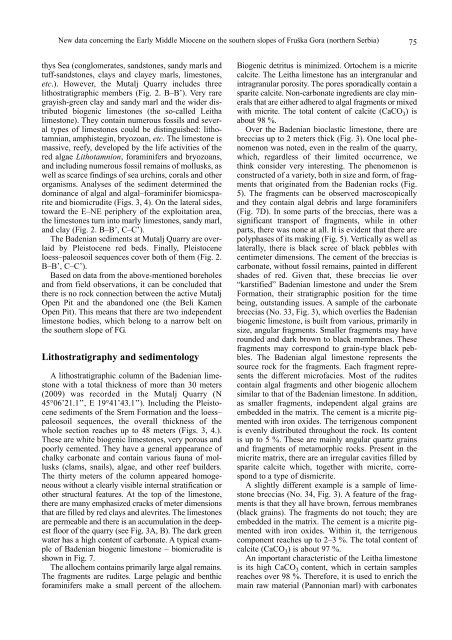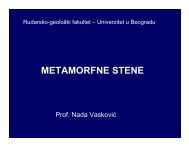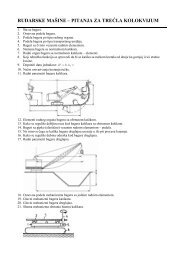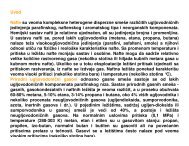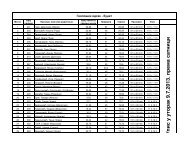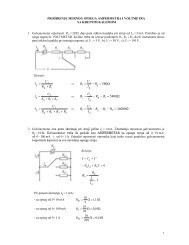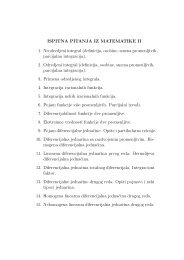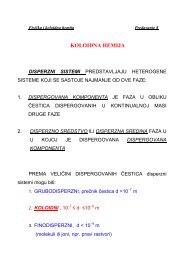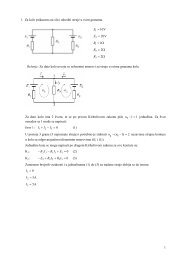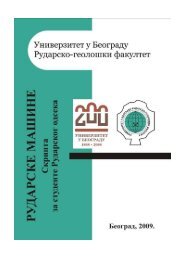KÑига LXXII
KÑига LXXII
KÑига LXXII
Create successful ePaper yourself
Turn your PDF publications into a flip-book with our unique Google optimized e-Paper software.
New data concerning the Early Middle Miocene on the southern slopes of Fruška Gora (northern Serbia) 75<br />
thys Sea (conglomerates, sandstones, sandy marls and<br />
tuff-sandstones, clays and clayey marls, limestones,<br />
etc.). However, the Mutalj Quarry includes three<br />
lithostratigraphic members (Fig. 2. B–B’). Very rare<br />
grayish-green clay and sandy marl and the wider distributed<br />
biogenic limestones (the so-called Leitha<br />
limestone). They contain numerous fossils and several<br />
types of limestones could be distinguished: lithotamnian,<br />
amphistegin, bryozoan, etc. The limestone is<br />
massive, reefy, developed by the life activities of the<br />
red algae Lithotamnion, foraminifers and bryozoans,<br />
and including numerous fossil remains of mollusks, as<br />
well as scarce findings of sea urchins, corals and other<br />
organisms. Analyses of the sediment determined the<br />
dominance of algal and algal–foraminifer biomicsparite<br />
and biomicrudite (Figs. 3, 4). On the lateral sides,<br />
toward the E–NE periphery of the exploitation area,<br />
the limestones turn into marly limestones, sandy marl,<br />
and clay (Fig. 2. B–B’, C–C’).<br />
The Badenian sediments at Mutalj Quarry are overlaid<br />
by Pleistocene red beds. Finally, Pleistocene<br />
loess–paleosoil sequences cover both of them (Fig. 2.<br />
B–B’, C–C’).<br />
Based on data from the above-mentioned boreholes<br />
and from field observations, it can be concluded that<br />
there is no rock connection between the active Mutalj<br />
Open Pit and the abandoned one (the Beli Kamen<br />
Open Pit). This means that there are two independent<br />
limestone bodies, which belong to a narrow belt on<br />
the southern slope of FG.<br />
Lithostratigraphy and sedimentology<br />
A lithostratigraphic column of the Badenian limestone<br />
with a total thickness of more than 30 meters<br />
(2009) was recorded in the Mutalj Quarry (N<br />
45°06’21.1’’, E 19°41’43.1’’). Including the Pleistocene<br />
sediments of the Srem Formation and the loess–<br />
paleosoil sequences, the overall thickness of the<br />
whole section reaches up to 48 meters (Figs. 3, 4.).<br />
These are white biogenic limestones, very porous and<br />
poorly cemented. They have a general appearance of<br />
chalky carbonate and contain various fauna of mollusks<br />
(clams, snails), algae, and other reef builders.<br />
The thirty meters of the column appeared homogeneous<br />
without a clearly visible internal stratification or<br />
other structural features. At the top of the limestone,<br />
there are many emphasized cracks of meter dimensions<br />
that are filled by red clays and alevrites. The limestones<br />
are permeable and there is an accumulation in the deepest<br />
floor of the quarry (see Fig. 3A, B). The dark green<br />
water has a high content of carbonate. A typical example<br />
of Badenian biogenic limestone – biomicrudite is<br />
shown in Fig. 7.<br />
The allochem contains primarily large algal remains.<br />
The fragments are rudites. Large pelagic and benthic<br />
foraminifers make a small percent of the allochem.<br />
Biogenic detritus is minimized. Ortochem is a micrite<br />
calcite. The Leitha limestone has an intergranular and<br />
intragranular porosity. The pores sporadically contain a<br />
sparite calcite. Non-carbonate ingredients are clay minerals<br />
that are either adhered to algal fragments or mixed<br />
with micrite. The total content of calcite (CaCO 3 ) is<br />
about 98 %.<br />
Over the Badenian bioclastic limestone, there are<br />
breccias up to 2 meters thick (Fig. 3). One local phenomenon<br />
was noted, even in the realm of the quarry,<br />
which, regardless of their limited occurrence, we<br />
think consider very interesting. The phenomenon is<br />
constructed of a variety, both in size and form, of fragments<br />
that originated from the Badenian rocks (Fig.<br />
5). The fragments can be observed macroscopically<br />
and they contain algal debris and large foraminifers<br />
(Fig. 7D). In some parts of the breccias, there was a<br />
significant transport of fragments, while in other<br />
parts, there was none at all. It is evident that there are<br />
polyphases of its making (Fig. 5). Vertically as well as<br />
laterally, there is black scree of black pebbles with<br />
centimeter dimensions. The cement of the breccias is<br />
carbonate, without fossil remains, painted in different<br />
shades of red. Given that, these breccias lie over<br />
“karstified” Badenian limestone and under the Srem<br />
Formation, their stratigraphic position for the time<br />
being, outstanding issues. A sample of the carbonate<br />
breccias (No. 33, Fig. 3), which overlies the Badenian<br />
biogenic limestone, is built from various, primarily in<br />
size, angular fragments. Smaller fragments may have<br />
rounded and dark brown to black membranes. These<br />
fragments may correspond to grain-type black pebbles.<br />
The Badenian algal limestone represents the<br />
source rock for the fragments. Each fragment represents<br />
the different microfacies. Most of the rudites<br />
contain algal fragments and other biogenic allochem<br />
similar to that of the Badenian limestone. In addition,<br />
as smaller fragments, independent algal grains are<br />
embedded in the matrix. The cement is a micrite pigmented<br />
with iron oxides. The terrigenous component<br />
is evenly distributed throughout the rock. Its content<br />
is up to 5 %. These are mainly angular quartz grains<br />
and fragments of metamorphic rocks. Present in the<br />
micrite matrix, there are an irregular cavities filled by<br />
sparite calcite which, together with micrite, correspond<br />
to a type of dismicrite.<br />
A slightly different example is a sample of limestone<br />
breccias (No. 34, Fig. 3). A feature of the fragments<br />
is that they all have brown, ferrous membranes<br />
(black grains). The fragments do not touch; they are<br />
embedded in the matrix. The cement is a micrite pigmented<br />
with iron oxides. Within it, the terrigenous<br />
component reaches up to 2–3 %. The total content of<br />
calcite (CaCO 3 ) is about 97 %.<br />
An important characteristic of the Leitha limestone<br />
is its high CaCO 3 content, which in certain samples<br />
reaches over 98 %. Therefore, it is used to enrich the<br />
main raw material (Pannonian marl) with carbonates


